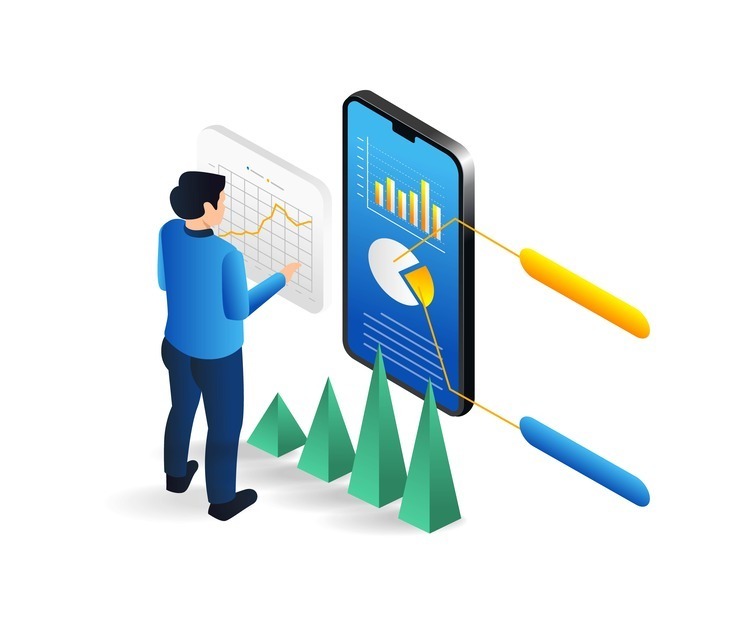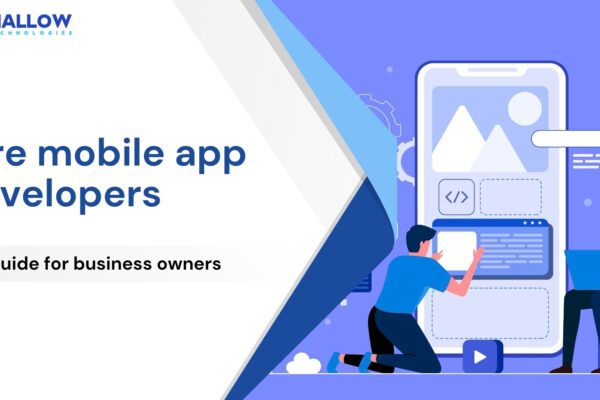Ever wondered what your iOS application users do once they’ve downloaded your application? Are you left in the dark about which features resonate most with your audience or how effective your latest marketing campaign truly is?
Many businesses overlook the goldmine of insights that lie within iOS application analytics, and as a result, find themselves grappling with critical blind spots in their strategies. Without a clear understanding of user behaviour, feature performance, and the impact of marketing initiatives, businesses risk missing out on opportunities for growth and improvement.
At Mallow, we’ve successfully helped clients launch iOS applications and always reinforce the pivotal role that analytics play in shaping the trajectory of an application. Over the years, we’ve honed our skills in interpreting complex data sets, unravelling user behaviour patterns, and extracting actionable insights to drive strategic decision-making.
By the end of the article, you will be equipped with the knowledge to not only unravel the mysteries of user engagement but also to harness this data to make informed decisions that can propel your businesses forward. In essence, reading this article is an opportunity for you to empower yourself with the tools and insights necessary to unlock the full potential of your iOS application.
Why do you need iOS app analytics?
Navigating the complex terrain of iOS app analytics requires a keen understanding of the diverse metrics and variables at play. From user acquisition and retention rates to in-app navigation and conversion funnels, each data point contributes to the larger narrative of an app’s performance. By making informed decisions based on user analytics, businesses can optimise their user experience, tailor marketing strategies, and respond dynamically to changing market demands. As highlighted by Branch.io, app analytics provide key data about app performance and user behavior, helping marketers and developers understand how their app is used and where improvements can be made.
Understanding user behaviour, engagement patterns, and feature performance is not just advantageous but absolutely essential for staying ahead in a highly competitive market. The sheer volume of data generated by users provides invaluable insights that can shape the trajectory of an app. Ultimately, the adoption of data-driven decision-making processes empowers developers and businesses to not just survive but thrive in the competitive realm of iOS app development.
What are some of the key metrics to track for analysing the growth of your business?
To make this easy to understand, we’re grouping the metrics to track into several different categories.
Acquisition and Retention Metrics

App downloads
The journey of a successful iOS application often begins with the metric of app downloads. Monitoring the number of downloads provides a foundational understanding of your application’s initial reach. This metric is crucial in assessing the effectiveness of marketing efforts, app store optimisation, and user interest. While app downloads alone do not guarantee success, they serve as a vital starting point for evaluating your application’s visibility and appeal in the competitive iOS ecosystem.
Geolocation – Utilise geolocation metrics to understand where users are engaging with your app. This data is valuable for geo-targeted content, personalised experiences, and analysing user behaviour based on location. It also enables businesses to tailor marketing strategies to specific regions.
User retention rate
User retention is a key indicator of an application’s ability to engage and retain its user base over time. The user retention rate measures the percentage of users who continue to use the app after their initial download. A high retention rate signifies that users find ongoing value in the app, while a declining rate may indicate potential issues with user experience, content, or feature relevance. Monitoring and improving user retention are essential for sustaining long-term success and fostering a loyal user community. According to Adjust, retention rates offer insights into engagement and churn, serving as a critical metric for assessing mobile app health and user loyalty.
Acquisition channels
Understanding where your users come from is integral to crafting effective marketing strategies. Acquisition channels encompass the various sources through which users discover and download your iOS application. These channels can include organic searches, paid advertisements, social media, referral programs, and more. Analysing acquisition channels helps identify the most effective sources, allowing businesses to allocate resources strategically and optimise their marketing efforts. By knowing which channels bring in the most engaged users, developers can tailor their acquisition strategies for maximum impact, enhancing both reach and user quality.
User engagement metrics

Daily active users (DAU) stands as a pivotal metric in assessing the immediate and short-term impact of your iOS application. This metric provides a real-time snapshot of the number of unique users actively engaging with your app on a daily basis. Monitoring DAU not only gauges the app’s popularity but also helps identify trends and patterns in user behaviour. According to a 2025 report by Business of Apps, about 16% of active users access apps daily, with the news & magazines category having the highest percentage of DAUs at 32%. An upward trajectory in DAU indicates a growing and engaged user base, while a decline might signal issues that require attention, whether in terms of user experience, marketing efforts, or feature performance. Tailor session metrics based on your app’s goals. For example, track the average session length or how often users engage with specific features during a session.
Monthly active users (MAU) offers a broader perspective, providing a measure of sustained engagement over a longer timeframe. This metric encompasses the total number of unique users who interact with your iOS app within a given month. MAU is instrumental in evaluating the app’s overall reach and user loyalty. A steady or increasing MAU suggests that the app is maintaining relevance and retaining its user base. For businesses aiming for long-term success, understanding MAU is essential in crafting strategies for user retention, feature enhancements, and overall user satisfaction.
Session duration delves into the amount of time users spend actively engaged within your iOS application during a single session. This metric is a direct indicator of user interest and the perceived value of your app. A longer session duration often correlates with higher user satisfaction and meaningful interactions. Monitoring session duration helps identify popular features and content, enabling developers and businesses to optimise user experiences based on what captivates their audience. Short session durations, on the other hand, may signal usability issues or a need for more engaging content within the app. Analysing this metric empowers iOS developers to tailor their app’s content and functionality to align with user preferences, ultimately fostering enhanced engagement and satisfaction.
User behaviour- related metrics

Heatmaps
Understanding how users interact with your iOS application is essential for enhancing user experience and optimising key features. Heatmaps visually represent user interactions by highlighting areas of the app that receive the most engagement. For example, a heatmap might reveal which buttons users click most frequently or which sections of a screen attract the most attention. Analysing heatmaps empowers developers to make informed design decisions, identify popular features, and address potential usability issues.
Recordings and behaviour flow
Recordings of user sessions provide an invaluable glimpse into how users navigate and engage with your app in real-time. As highlighted by UXCam, session recordings offer you a window into real user interactions, revealing insights that standard analytics might miss, thereby enabling developers to identify pain points and improve user experience. By recording user interactions, developers can observe the entire user journey, from app launch to specific actions taken within the interface. This not only aids in identifying pain points but also unveils patterns in user behaviour. Coupled with behaviour flow analysis, which visualises the sequential path users take through the app, these tools offer comprehensive insights into the user experience. This understanding enables developers to streamline navigation, enhance user paths, and create a more intuitive app.
Moreover, through user behaviour flow, you’ll be able to pinpoint areas or steps where the drop rate is higher. This crucial insight allows developers to focus on optimising specific aspects of the app experience, addressing issues that might be causing users to disengage. By identifying these drop-off points, developers can implement targeted improvements, ultimately improving user retention and satisfaction.
Page visits metrics
Page visits metrics provide a quantitative overview of user engagement with different sections or pages within your iOS application. By analysing which pages users visit most frequently and how much time they spend on each page, developers can gain insights into content relevance and user preferences. This data informs decisions related to content placement, feature prominence, and overall app layout. Whether it’s optimising the home screen or refining in-app navigation, page visit metrics offer actionable data to align the app with user expectations and preferences.
Please note that the collection and analysis of user data, are subject to user consent. Before proceeding with the tracking and gathering of such details for sampling during analysis, it is imperative to obtain explicit consent from the users.
Custom application-related metrics

Custom application metrics provide a tailored view of your iOS application’s performance, offering insights specific to your unique business objectives and user experience. Here are several types of custom metrics that can be valuable for understanding and optimising your app:
- Conversion rates – Measure the effectiveness of specific actions or user flows within your app. For example, track the conversion rate from app downloads to account registrations or from product views to purchases.
- Gender and age-related metrics – Implementing gender and age-related metrics enables your iOS application to gather information on the age groups and gender distribution of its users. This data can be instrumental in shaping targeted marketing strategies, optimising user interfaces, and personalising content to cater to specific demographics.
- Feature adoption – Understand how users engage with specific features by tracking adoption rates. This involves monitoring the number of users who actively use a new feature or functionality introduced in an update.
- Custom events – Define and track events that are specific to your app’s functionality. This could include interactions like button clicks, form submissions, or any other user actions that are crucial for your application’s success.
- User segmentation – Segment users based on custom criteria such as demographics, geographic location, or user behaviour. This allows for more targeted analysis and personalised strategies.
- In-app purchases and revenue metrics – Monitor the performance of in-app purchases and revenue generation. Track key metrics like average revenue per user (ARPU), customer lifetime value (CLV), and the success of promotional campaigns.
- Custom engagement scores – Develop a custom engagement score that combines various user interactions and behaviours to provide a comprehensive view of user engagement levels. This score can help identify highly engaged users versus those who may need re-engagement strategies.
- User feedback analysis – Analyse user feedback from reviews, surveys, or direct communication channels. Categorise and quantify feedback to identify common themes, concerns, or positive aspects, guiding future updates and improvements.
Performance Metrics

Performance metrics are critical for ensuring a seamless and efficient user experience. Here are key metrics that focus on the performance aspects of your iOS application:
- Load times – Assess the time it takes for your app to load and become fully functional. Break down load times for different components, screens, or features to pinpoint areas that may need optimisation. Metrics like app launch time and screen rendering times are crucial for user satisfaction.
- Network performance – Evaluate the speed and reliability of network requests made by your application. Metrics such as API response times, latency, and network errors can help identify bottlenecks and optimise data fetching processes.
- Frame rate – Monitor the frame rate at which your app renders animations and transitions. A smooth frame rate contributes to a positive user experience. Metrics like frames per second (FPS) can reveal performance issues affecting animations.
- Battery consumption – Assess the impact of your app on device battery life. Battery consumption metrics help identify resource-intensive processes or background activities that may contribute to excessive power usage.
- User response time – Measure the time it takes for the app to respond to user interactions, such as button clicks or screen swipes. Analyse response time metrics to ensure a snappy and responsive user interface.
- Application error rates and crashes – Track the frequency of errors and exceptions occurring within the application. Identify patterns and trends in error rates to proactively address issues that may impact performance and user satisfaction. Regularly monitor and analyse application crash reports to identify and resolve issues that impact stability. Metrics such as crash frequency, crash-free users, and specific crash logs provide insights into the overall health of your application.
- App size – Monitor the size of your app installation package. App size can impact download times, storage requirements, and user willingness to install or update the application.
Device-related metrics

Collect and analyse device-specific data, including information on device models, screen sizes, and operating system versions. These metrics provide insights into the diversity of devices your app supports, aiding in optimisation for various screen resolutions and ensuring compatibility with different iOS versions.
Below mentioned table will give you some overview of the examples of some tools that can be effectively used to measure and analyse the different metrics for iOS applications:
| Analytics Tool | Tracked Metrics |
| Google analytics for mobile | User Engagement (Sessions, Active Users)Crash ReportsUser Acquisition (Source, Medium, Campaign)Retention RateIn-App Events (Custom Events)Conversion TrackingEvent tracking for E-commerce and purchase eventsUser behaviour flow metrics Funnel Metrics |
| Firebase analytics | User Engagement (Active Users, Retention)Crash ReportingUser Behaviour (In-App Purchases, Conversions)Audience SegmentationConversion TrackingCustom Events and Parameters |
| Flurry analytics | User RetentionAd PerformanceSession FrequencyDemographics and User CharacteristicsEvents and Event SegmentationGeographic Distribution |
| Mixpanel | Funnel Analysis and metricsUser RetentionA/B TestingNotifications and Push AnalyticsRevenue TrackingUser Surveys and FeedbackUser behaviour flow metric |
| Amplitude | Behavioural AnalyticsUser SegmentationEvent TrackingRetention AnalysisConversion Funnel AnalysisRevenue Metrics |
| Countly | Session and User RetentionUser SegmentationFunnel AnalysisCrash ReportingPerformance Monitoring |
| Heap analytics | User Interactions and EventsFunnel AnalysisRetention and Conversion TrackingClick and Scroll HeatmapsA/B TestingSession replayHeatmapsUser journey |
| Smartlook | Session RecordingsHeatmapsEvent TrackingConversion FunnelsError TrackingRetention Analytics |
| Uxcam | Session RecordingsTouch HeatmapsUser AnalyticsConversion FunnelsIssue detection |
What would your journey from idea to app store look like?
At this point, you possess a comprehensive understanding of how iOS application analytics can empower you to make informed, data-driven decisions. You are well-aware of the ways in which you can leverage available iOS application analytics to enhance decision-making.
After analyzing the analytics of your business application, if you find that the metrics aren’t reflecting positive outcomes, it’s crucial to optimise the performance of your iOS application. Poor results from the analytics could signify issues such as slow loading times, crashes, or inefficient user experiences, all of which can deter users and impact business success. This emphasises the need to enhance the application’s performance to ensure seamless functionality and user experience. For more details on how to optimise iOS application performance, do check out the article on how to optimise iOS application performance.
Still unsure about your next step? Feel free to reach out to our team.
Your queries, our answers
Mobile application development involves creating software applications designed to run on mobile devices like smartphones and tablets. These apps can be native (built specifically for iOS or Android), cross-platform (designed to work on multiple platforms), or hybrid (combining elements of both).
Our mobile app development process includes the following stages: requirement gathering and analysis, design and prototyping, development and coding, testing and quality assurance, deployment, and post-launch support. Each stage is crucial to delivering a high-quality application.
To gain deeper insights into the experience of working on a mobile project with Mallow, explore more details here.
The choice between native and cross-platform development depends on your project’s goals, budget, and target audience. Native apps offer better performance and a more tailored user experience, while cross-platform apps allow for faster development and lower costs by using a single codebase for multiple platforms. For a detailed comparison of Native vs. Hybrid development, explore our comprehensive analysis to help you make an informed choice.
Mallow develops mobile apps for iOS, Android, and cross-platform solutions. We use the latest technologies and frameworks to ensure your app performs optimally on the platforms that matter most to your users.
Choosing the right features for your mobile app depends on understanding your target audience, business goals, and budget. We work closely with you to prioritize features that will provide the most value to your users and align with your business objectives.
At Mallow, we offer ongoing app maintenance and updates as part of our post-launch services. This includes regular updates to improve performance, add new features, and ensure compatibility with the latest operating systems. For more details, get in touch with our team.
Yes, Mallow assists with the entire app store submission process, including meeting the guidelines for Apple’s App Store and Google Play. We ensure your app is ready for submission and provide support to help it get approved.
Mallow uses a variety of technologies and frameworks for mobile app development, including Swift and Objective-C for iOS, Kotlin and Java for Android, and React Native and Flutter for cross-platform development. Our technology choices are driven by the specific needs of your project.
Our testing process includes functional testing, performance testing, security testing, usability testing, and compatibility testing across different devices and operating systems. We ensure your app is bug-free and performs optimally before it goes live.
The cost of developing a mobile app depends on several factors, including the app’s complexity, features, platform (iOS, Android, or both), and the development team’s expertise. Costs can range from $10,000 to $150,000 or more. To know more, check out how much it costs to work on a mobile project with us.
The development timeline for a mobile app varies depending on the complexity of the project. A basic app may take 2-4 months to develop, while a more complex app with advanced features can take 6-12 months or longer.
Choosing the right features for your mobile app depends on understanding your target audience, business goals, and budget. We work closely with you to prioritize features that will provide the most value to your users and align with your business objectives.
Yes, Mallow offers comprehensive post-launch support, including monitoring, updates, bug fixes, and enhancements. We ensure your app remains up-to-date and continues to perform well after it’s launched.
A mobile app can enhance customer engagement, increase brand visibility, provide better service through personalized experiences, and create new revenue streams. It also allows you to reach a broader audience by making your services more accessible on mobile devices.
Getting started with Mallow is easy! Simply reach out to us to discuss your project. We’ll work with you to understand your goals, define your requirements, and create a development plan that meets your needs. Let’s bring your mobile app idea to life!.
Security is a top priority at Mallow. We implement advanced security measures, including encryption, secure authentication, and regular security audits, to protect your app from potential threats and ensure data integrity.
To learn more about how we handle and implement these security measures, check out more details here.
Author
Yogesh Murugesh
Yogesh is an accomplished Senior Technical Lead at Mallow, boasting over 11 years of invaluable expertise in the realm of application development. With an extensive background spanning diverse domains, he has consistently delivered applications of the highest calibre. Yogesh's commitment to quality and excellence shines through in every project he undertakes. His career journey is marked by a proven track record of successfully crafting applications that not only meet but often exceed industry standards. His ability to navigate through various domains showcases his adaptability and keen problem-solving skills. Yogesh's contributions have consistently played a pivotal role in driving technological innovation and advancement within his field. Beyond his professional pursuits, Yogesh finds solace and joy in various activities. An ardent cricket enthusiast, he embraces the team spirit and strategic thinking that the sport demands. During leisure moments, he indulges in watching movies, allowing himself to be captivated by different narratives and genres. Moreover, Yogesh cherishes quality time with his child, relishing the role of a devoted parent.



